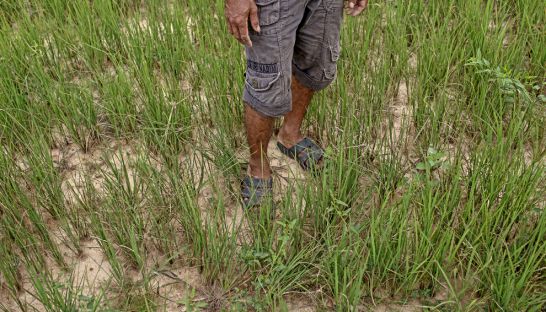Crop insurance takes root
Crop insurance takes root
A pilot project that offers micro-insurance to help rice farmers cope with the risks of flooding and drought is looking to build on the success of its first season by scaling up beyond three existing provinces.

The Cambodia Micro Agriculture Insurance Scheme (CAMAIS), launched in the second half of 2015, aims to support local smallholder farmers by providing insurance payouts to those affected by severe weather-related events attributed to climate change.
Rice farmers who join the scheme pay an insurance fee at the start of the growing season based on the of their farm, type of paddy grown and technical tools used. In return, they receive consultation on farming techniques and get an insurance payout if their crop is damaged either by flood or drought.
“All members can get free technical consultation and information on climate change, as well as assistance on making claims for damaged or failed crops,” explained Lak Youssey, project manager of CAMAIS.
According to Youssey, 153 agricultural families joined the micro-insurance scheme during its first season, paying a total premium of $1,230 to insure 136 hectares of rice farms. At the end of the season, roughly 80 per cent of this collected capital was used to settle farmers’ claims, with the rest used to cover operational expenses and commissions for agents.
Around half of the rice farmers that purchased the crop insurance made compensation claims based on varying amounts of crop damage; however, only 52 of these claims met the criteria for receiving compensation, Youssey said.
The two-year project was launched with $96,000 funding from Netherlands-based Foundation Achmea, which supports socio-economically disadvantaged rural communities in developing countries. It is being implemented by the Cambodian Centre for Study and Development in Agriculture (CEDAC) across nine districts in three provinces: Kampong Chhnang, Takeo and Kampong Speu.
“This is a successful project because it has benefitted the farmers, and since it is not a profit-making project the premiums all go back to helping the farmers,” said Youssey.
Climate change experts predict that Cambodia will experience longer dry seasons and shorter, more intense rainy seasons, increasing the frequency and severity of floods and drought.
One of the goals of the CAMAIS project is to reduce cases where families whose crops are damaged or destroyed by climate-related disasters are forced to take out loans from financial institutions to rebuild their farms.
Smallholder farmers unable to afford the high interest rates on these loans often sell their land to settle their debts.
According to Youssey, CEDAC plans to extend the micro-insurance scheme to three new districts in Kampong Chhnang province and cover a total of 1,500 families in 2016. The long-term goal is make the scheme available in all of the 22 provinces where CEDAC has a presence.
Huy Vatharo, chairman of the Insurance Association of Cambodia, said crop insurance was a new concept in the Kingdom that offers a potential market for insurers, but remains poorly understood.
“It’s a good opportunity for insurance companies to take a look at the agriculture sector,” he said, “But the challenge will be the time it takes to make farmers understand these schemes and build confidence in its potential benefits.”
Som Song, director of Agricultural Development Chamroeurn Phal, an agricultural cooperative in Battambang’s Raing Kesei commune, said he had heard of the project and was keen for the scheme to be introduced in his district.
“I heard in an event that CEDAC was providing crop insurance and if it is provided in my area it would be helpful to us,” he said.
According to Song, 260 farmers in his cooperative were affected by climate-related crop damage last year and an insurance scheme would provide assistance and financial support for those affected.














